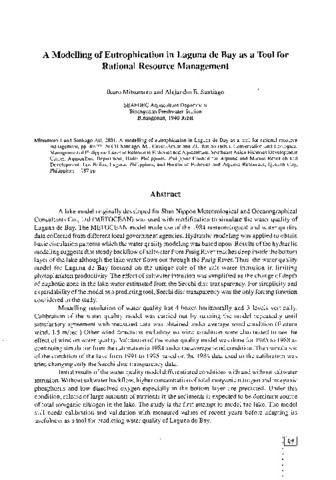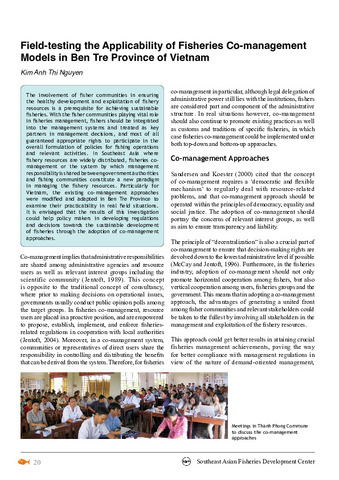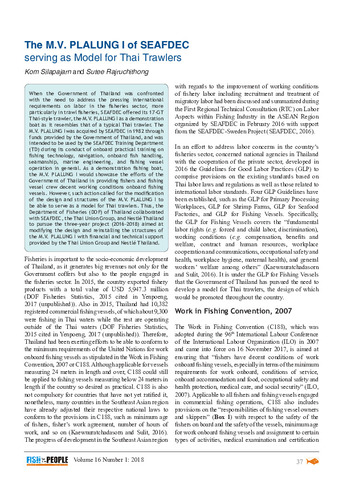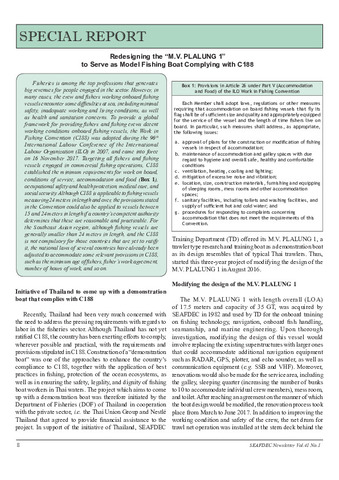A modelling of eutrophication in Laguna de Bay as a tool for rational resources management
Share
Abstract
A lake model originally developed for Shin-Nippon Meteorological and Oceanographical Consultants Co., Ltd (METOCEAN) was used with modification to simulate the water quality of Laguna de Bay. The METOCEAN model made use of the 1984 meteorological and water quality data collected from different local government agencies. Hydraulic modeling was applied to obtain basic circulation patterns which the water quality modeling was based upon. Results of the hydraulic modeling suggests that steady backflow of saltwater from Pasig River reaches deep inside the bottom layer of the lake although the lake water flows out through the Pasig River. Thus, the water quality model for Laguna de Bay focused on the unique role of the salt water intrusion in limiting phytoplankton productivity. The effect of saltwater intrusion was simplified as the change of depth of euphotic zone in the lake water estimated from the Secchi disc transparency. For simplicity and expandability of the model as a predicting tool, Secchi disc transparency was the only forcing function considered in the study.
Modelling resolution of water quality has 4 boxes horizontally and 3 levels vertically. Calibration of the water quality model was carried out by running the model repeatedly until satisfactory agreement with measured data was obtained under average wind condition (Eastern wind, 1.5 m/sec.) Other wind directions including no wind condition were also tested to see the effect of wind on water quality. Validation of the water quality model was done for 1985 to 1988 as continuing simulation from the calibration in 1984 under the average wind condition. Then simulation of the condition of the lake from 1991 to 1995 based on the 1984 data used in the calibration was tried changing only the Secchi disc transparency data.
Initial results of the water quality model differentiated conditions with and without saltwater intrusion. Without saltwater backflow, higher concentration of total inorganic nitrogen and inorganic phosphorus and low dissolved oxygen especially in the bottom layer are predicted. Under this condition, release of large amounts of nutrients in the sediments is expected to be dominant source of total inorganic nitrogen in the lake. The study is the first attempt to model the lake. The model still needs calibration and validation with measured values of recent years before adapting its usefulness as a tool for predicting water quality of Laguna de Bay.
Suggested Citation
Mitsumoto, I. & Santiago, A. E. (2001). A modelling of eutrophication in Laguna de Bay as a tool for rational resource management. In C. B. Santiago, M. L. Cuvin-Aralar, & Z. U. Basiao (Eds.), Conservation and Ecological Management of Philippine Lakes in Relation to Fisheries and Aquaculture. (pp. 49-73). Tigbauan, Iloilo, Philippines: Aquaculture Department, Southeast Asian Fisheries Development Center; Los Baños, Laguna, Philippines: Philippine Council for Aquatic and Marine Research and Development (PCAMRD), Department of Science and Technology; Quezon City, Philippines: Bureau of Fisheries and Aquatic Resources (BFAR), Department of Agriculture, Quezon City, Philippines.
Subject
Related items
Showing items related by title, author, creator and subject.
-
Field-testing the applicability of fisheries co-management models in Ben Tre Province of Vietnam
Thi Nguyen, Kim Anh (Secretariat, Southeast Asian Fisheries Development Center, 2012) -
The M.V. Plalung I of SEAFDEC serving as model for Thai trawlers
Silapajarn, Kom; Rajruchithong, Sutee (Secretariat, Southeast Asian Fisheries Development Center, 2018)When the Government of Thailand was confronted with the need to address the pressing international requirements on labor in the fisheries sector, more particularly in trawl fisheries, SEAFDEC offered its 17-GT Thai-style ... -
Redesigning the “M.V. PLALUNG 1” to serve as model fishing boat complying with C188
Training Department, Southeast Asian Fisheries Development Center (Secretariat, Southeast Asian Fisheries Development Center, 2018)Fisheries is among the top professions that generates big revenues for people engaged in the sector. However, in many cases, the crew and fishers working onboard fishing vessels encounter some difficulties at sea, including ...





